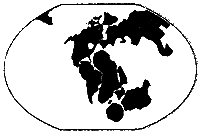    |
| Jurassic Period First Birds and the Reign of the Dinosaurs (201-144 mya) |
 Global View - Where was Nova Scotia?
Global View - Where was Nova Scotia?As the Jurassic Period succeeded the Triassic (201 mya), the continental rifting process became more intense, further stressing the already weakened crust. The main split in Pangea was to the east of Nova Scotia and occurred during the Jurassic, forming the new Atlantic Ocean. Click here to see an animated image of the Atlantic Ocean forming. (127k) Rocks of Nova Scotia The earth's crust split open during the rifting process and molten magma spewed from the fissures along what is now the Bay of Fundy. Fiery lava fountains spread over the red sandstones, cooling into layer after layer of dark basaltic rock. Today, this can be seen along the southern side of the Bay of Fundy as today's North Mountain. Alternating dry and wet cycles continued into the Jurassic, depositing sandstones and siltstones on top of the basalt. Except for a few small exposures of Cretaceous clays and sandstones, the Early Jurassic rocks were the last known rocks deposited onshore in Nova Scotia before the Pleistocene glaciations. Offshore on the continental shelf, thick Jurassic deposits record the breakup of Pangea and the development of the Atlantic Ocean margin. Paleoenvironment The dramatic and fierce geological processes of the Jurassic Period were reflected by unsettled climatic conditions. Although considered temperate, the warm to hot climate alternated between dry and wet periods. Dinosaurs flourished at this time, as we can see from the fossils found at Parrsboro, and the first birds were taking wing. |
![[Nova Scotia Museum]](../graphics/nsmlogo.gif)